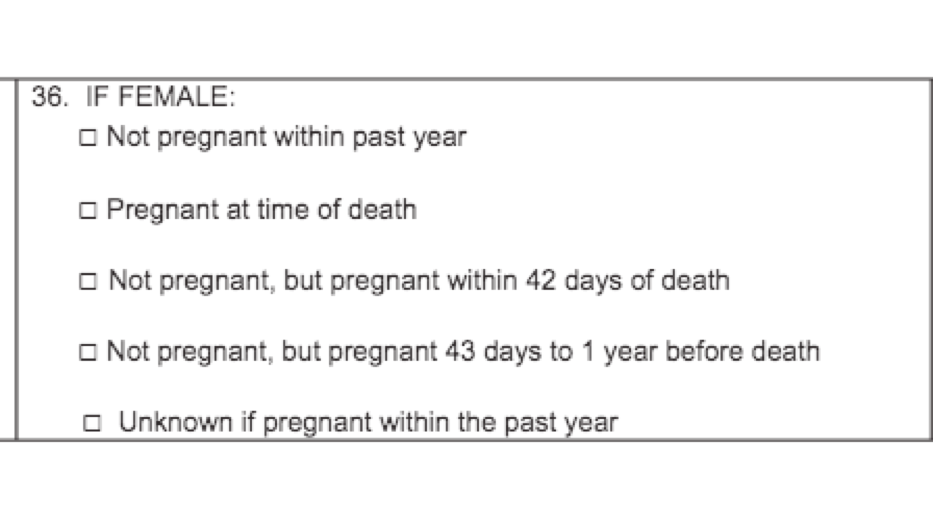Maternal Mortality and the Pregnancy Checkbox

The United States has the highest maternal mortality rate among developed countries. That mortality rate is increasing, in part due to drug overdose deaths and domestic violence. New restrictions on abortion will impact that mortality rate. All physicians and death investigators should understand the importance of the pregnancy checkbox on death certificates for women and girls.
Maternal mortality is a huge and complex topic. This post focuses on just one aspect: the pregnancy checkbox on the death certificate and how that data is used.
Two Data Paths
Coroner and medical examiner offices are critical sources of data about maternal deaths. In one multi-state study, coroners and medical examiners (C/MEs) were responsible for certifying about 60% of maternal deaths. Certification of death for women requires determination of the cause and manner of death, but also completion of a pregnancy checkbox. Autopsy, toxicology, and case narratives produced by C/ME offices are additional sources of data about maternal deaths.
Data from C/ME offices enter two separate but related paths. Death certificate data are coded into a national statistical database by the Center for Disease Control and Prevention (CDC). Death certificate data and source data like case narratives and autopsy reports are reviewed by Maternal Mortality Review Committees (MMRCs).

Maternal Mortality Defined
Why are there 5 different checkboxes for pregnancy status? That’s because the two end users of the data, the CDC and MMRCs, use different definitions of maternal mortality. The CDC, like the World Health Organization, defines a maternal death as “death while pregnant or within 42 days of the end of pregnancy.” It excludes deaths from accidental or incidental causes.
MMRCs look at the bigger picture. They often review all ‘pregnancy-associated deaths,’ which includes the death of any woman (or girl) who was pregnant within the year before they died.
Roy Hoffman, MD, MPH, Medical Director of Philadelphia’s Fatality Review Committee and a member of Pennsylvania’s MMRC, favors MMRCs casting a broad net to identify cases to review. Dr. Hoffman points out that it is up to the case review process to determine if the death is pregnancy-related – a true maternal death. The MMRC then assesses whether and how that death might have been prevented.
Why Pregnancy Checkbox Accuracy Matters
An accurate death certificate is essential for both data paths. In fact, CDC suspended publication of maternal mortality rates from 2007 to 2018 because of uneven state adoption of the pregnancy checkbox. There were also problems with accuracy of the checkbox, including over-reporting pregnancy in older women. CDC implemented a new coding method in 2018 to address this problem. Now a maternal death is only recorded for women over 45 with a positive checkbox IF the cause of death is related to the pregnancy. For women under age 45, the pregnancy checkbox will continue to determine which deaths are coded as maternal deaths by CDC. MMRCs presumably continue to review all cases with any positive checkbox.
MMRCs also rely on death certificate pregnancy checkboxes to identify cases for review. If a case is identified, the Committee will ask physicians, coroners, and medical examiners for additional information, especially autopsy and toxicology reports. The MMRC reviews all identified cases to determine if a death was pregnancy-related or not. If it is considered to be related, the MMRC then assesses whether and how that death might have been prevented.
What can Coroners Do about Maternal Mortality?
C/MEs are key to improving the accuracy of the pregnancy checkbox and therefore our knowledge of maternal mortality. Death investigators should look for gynecologic medical records when investigating the death of women of child-bearing age (anything from 10-60 years these days). They should also ask family and friends about any recent pregnancy of a deceased woman as routinely as they ask about other sensitive topics.
Pennsylvania’s MMRC
Pennsylvania has a county level Fatality Review Program in Philadelphia and, since 2019, a state MMRC. Coroners and medical examiners are supposed to be represented on the Committee, but participation has been spotty. The unique knowledge and experience of medicolegal death investigators is essential to the effectiveness of MMRCs. If any coroner wants more information about what being a member involves, contact me. The PA MMRC’s first report and a membership application are available here.
Note: This post was updated on February 19, 2023.